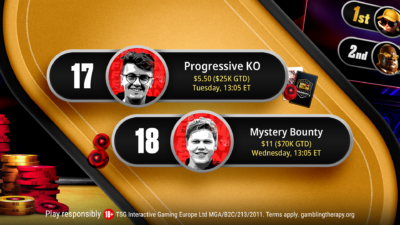In The Canary Murder Case, Philo Vance sits down with a group of murder suspects for a game of five-card draw. When the game is done, he knows which among them is the killer.
Anthony Holden once famously wrote that a person’s “character is stripped bare at the poker table.” It’s a truth well understood by anyone who has played the game at all seriously. You necessarily expose something about yourself at the poker table. Indeed, a big part of the game is trying to keep your cards “close to the vest,” both literally and figuratively.
The 1929 film The Canary Murder Case tests this idea to an extreme, you could say. The film features a poker game expressly set up in order to get someone to expose himself sufficiently to reveal he could have committed a murder. And it works!
Catching the Canary’s Killer
The Canary Murder Case loosely adapts one of a dozen popular novels written by Willard Huntington Wright, who used the pen name S. S. Van Dine to author his series of “Philo Vance” mysteries. The film’s plot doesn’t quite match that of the novel, but it does begin with a similar murder of a showgirl known for her stage performances as “The Canary.”
This early sound film is remembered for a few reasons. It features the first starring role of William Powell, the debonair leading man who went on to appear in several films as the suave sleuth Vance. He later also starred in the “Thin Man” series of films where he portrayed Dashiell Hammett’s crime-solving character Nick Charles.
The movie is also known for starring flapper icon Louise Brooks as the Canary. Already a sex symbol, Brooks’ notoriety grew further when she refused producers’ demands for her to re-record some of her lines for the film. That got her blacklisted by American studios. She would go on to star in some groundbreaking (and, for the era, sexually provocative) European films, becoming identified with a character she portrayed in a couple of them — Lulu.
It only takes 20 minutes for us to learn the Canary is not only romantically linked to several men, but is scheming to blackmail some of them, too. Thus when she is found murdered a number of suspects soon emerge, each having possible motives. A second murder occurs as well, clearly committed by the same killer to cover up the first, adding extra urgency to finding out “whodunit.”
I’ll gloss over further details of the plot in order for us to skip ahead to the poker game. In the novel, Vance explains more thoroughly how he thinks he knows what kind of person committed the murder, but he isn’t “sufficiently acquainted with the suspects to point out the guilty one.” Nor does he have enough concrete evidence yet to pin it on any of the men who have been identified as having possibly killed the Canary.
Prefiguring Holden’s pronouncement, Vance insists that “a man’s true nature always comes out in a game poker.” He therefore believes if he can get the suspects to play poker with him, he’ll be able to figure out which among them is capable of being the killer.
Vance Begins Discarding Suspects
A game of five-card draw is arranged. In the first hand one of the men, Cleaver, draws himself a strong hand but plays it timidly:
As Vance explains later, Cleaver only calling a small bet with three aces proves he is “much too cautious, and entirely lacking in the necessary boldness” to have been the murderer.
Next Vance gets heads-up against an opponent named Mannix, and after drawing two cards watches Mannix stand pat. Then comes a big overbet from Mannix, with Vance calling. It turns out Mannix had something worth betting:
A Bluffer Reveals Himself
Finally we get to Spotswoode, someone whose alibi was in fact apparently playing in another poker at the time the Canary was murdered. Again, Vance gets heads-up, and after Vance draws three and Spotswoode stands pat, a huge pot develops after both players put in big raises back and forth.
Finally Vance calls, and the showdown surprises everyone:
You could say Vance has called Spotswoode’s bluff in a couple of different ways, the most important being the way he now knows Spotswoode to be the only player at the table clever and cunning enough to be the murderer.
Here’s the analysis Vance provides after the game in which he explains why Spotswoode has to be the killer:
The novel features the poker game as well, albeit with some altered details both of the hands and the circumstances. In fact, Vance brings another player to the game who cheats by setting up certain hands to ensure Vance is able to test out each suspect’s psychological mettle.
In fact, the hand between Spotswoode and Vance is handled better in the movie than in the book — in the latter, Vance folds four aces face up to Spotswoode’s bluff with jack-high.
Talk About Circumstantial Evidence
In his famous Stud Poker Blue Book first published in 1931, George Henry Fisher thought so much of the poker game in The Canary Murder Case he devoted a chapter to sharing it — despite the fact that his book was about stud poker, not draw. For Fisher, the hand didn’t necessarily provide a lesson in how to solve a murder, but a lesson in how to bluff (i.e., “when appearances are entirely in one’s favor”).
It has been 90 years since this movie premiered, so I don’t feel bad about delivering spoilers. Vance was right — Spotswoode is the killer. You’ll be glad to know other, more concrete evidence helps confirm Vance’s suspicion, which means it wasn’t just a bluff that determined Spotswoode to be guilty.
That is to say, if you happen to be capable of such bold deception at the poker table, legally speaking that probably cannot be held against you. Pulling off a killer bluff doesn’t make you a bluffing killer.


More “5-Card Fiction”
- Paul Newman surprisingly turns over four jacks in ‘The Sting’
- Three hands in ‘Rounders’ screenplay draft that didn’t make it to the screen
- Evoking Stu Ungar with a 10-high call on ‘Billions’
“5-Card Fiction” is an ongoing series examining fictional poker hands from film, television, and elsewhere. Have a favorite fictional poker hand you’d like to see discussed? Tweet your suggestions @PokerStarsBlog.
Back to Top






